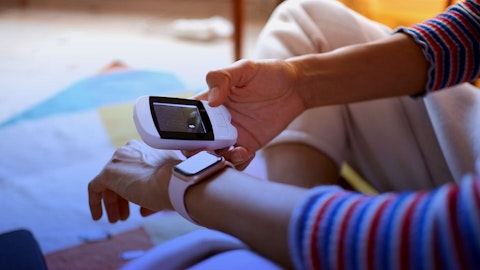Perspectives

Right now, digital health solutions are gaining traction across the healthcare ecosystem – there are even adverts on TV for a digital healthcare solution, small plastic glucose detectors that can be attached to your arm if you suffer from diabetes. It’s a huge improvement on the need to do pin prick tests multiple times a day.
Symptom/metric trackers, such as these in diabetes, are one of the breakout sectors for digital healthcare – our research shows that 22% of people living with diabetes globally now own a smart meter with a further 16% planning to buy one in the next 12 months.
But this is just the start of the digital healthcare revolution. We think the next big sectors could be passive tracking and early identification of disease.
Firstly, the passive tracking of symptoms using AI, connected devices and more to monitor conditions such as dementia, COPD, asthma and MS in real-time. By tracking factors such as our speech, cough frequency, breathing and movement, data can be processed using AI to see when conditions are getting worse.
The trend will be to move away from patient-entered digital symptom trackers, where long-term compliance is poor, to new ways of collecting the data that require no effort from those living with these conditions.
A great example is the Sonde Health project, which is currently testing whether vocal biomarkers can be used for remote detection and monitoring of mild cognitive impairment at home.
Such tools can not only help keep people living at home (with the better quality of life that creates) but also save money for healthcare providers. Another area of benefit is consistent monitoring, giving doctors access to objective information and helping them make smarter treatment decisions.
A second area of opportunity is the use of AI, digital biomarkers and more for the early detection of disease or even the identification of people at risk of developing an illness in the future. This approach is also expected to lead to better patient outcomes (and reduced healthcare costs). We know that conditions such as cancer and dementia can be better treated the earlier they are spotted.
With healthcare systems holding increasingly large amounts of data about us, the opportunities for interrogation are only going to grow. Similarly, advances in nanotechnologies and other biosensors will ensure devices become cheaper and more accessible. This could have a huge impact in reducing mortality in low- and middle-income countries, where early diagnosis of cancer, diabetes and infectious diseases such as malaria, SARS and viral hepatitis will lead to improved patient outcomes.
MIT researchers in the US, for example, have used AI to provide a more accurate assessment of lung cancer risk. Using CT scans and a computer model trained to spot early-stage lung cancer, the technology provides an opportunity to enhance screening programmes.
The success formula for start-ups
VC funding is reaching significant levels in the digital healthcare sector, with more than 10 of those listed on CB Insights Top 150 for digital health having raised more than $100m, led by Availity from the US, which has picked up $400m.
The difference between start-up success and failure appears to come down to:
Whether the development/ product answers a clear unmet need (clinical, ecosystem or patient-led);
- The team having a clear focus on who the gatekeepers are, with a plan on who to contact when, particularly when it comes to funding and adoption;
- The identification of relevant funding streams;
- A plan to provide robust clinical data to support the tool, as this is an expectation for many medical stakeholders before they will consider adopting a new tool; and
- Owning clear IP for the tool as this is an increasingly competitive area.
While patient self-funding in markets such as China is common, in other markets, the situation is more complex. The German healthcare system, for example, allows some devices to be paid for, but only if they meet strict criteria.
Certainly, securing clear IP should be a goal, particularly if regulatory approval is going to take time. The diabetes device market, for example, is already very crowded and has rapidly become commoditised.
There are challenges, however, when it comes to digital health with regard to privacy – in all five markets tracked by our Patient Trendscoping study, doctors and hospitals were significantly more trusted than independent app developers, pharmaceutical companies and tech giants with personal data.
The key patient groups
Looking at which patients to target for patient-oriented digital health tools, there are two groups of patients that matter. Firstly, the people who love this stuff, often younger and more active, want to be tracking their key metrics. Our data shows that for every device currently in the market – from glucose monitors to connected inhalers, uptake among Gen Z and Millennials is dramatically higher than for Baby Boomers.
Secondly, older groups and those with chronic conditions have the greatest need for new technology but may need help to implement it. Often we find that the former group acts as an enabler for the latter (their parents) – helping them get established with new digital tools and helping them live in their homes.
Currently, device ownership is highest globally for people with one chronic condition, with 30% of this group owning an oximeter or a glucose monitor and 29% having a connected pressure cuff.
In all areas of digital health, we see the highest adoption of tools amongst Millennials (with Gen Z close behind). There’s also strong geographical variation adoption of (and interest in) tools is highest in China, closely followed by the US. Figures for interest and use are often very similar for Germany, UK and Japan. However, device ownership can lag behind in Japan.
The good news, however, is that once owned, health-specific smart tools are heavily used, whatever the market.
The digital health revolution is already transforming the lives of many with chronic conditions. And with current healthcare systems not able to provide adequately for many sufferers, the potential








